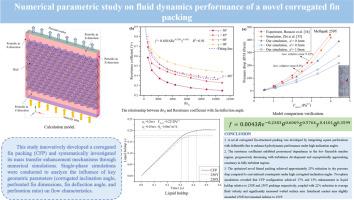一种新型波纹翅片填料流体力学性能的数值参数研究
IF 3.9
3区 工程技术
Q3 ENERGY & FUELS
Chemical Engineering and Processing - Process Intensification
Pub Date : 2025-09-12
DOI:10.1016/j.cep.2025.110551
引用次数: 0
摘要
燃烧后二氧化碳化学吸收是一种很有前途的碳捕获技术。在化学吸收过程中,结构填料通常用于吸收器和解吸器。虽然结构填料提供了广泛的界面表面积来促进气液反应,但同时也导致整个吸收系统的压降升高。本文创新性地开发了一种波纹翅片填料(CFP),并以双板模型为重复单元,在周期边界条件下对其传质强化机理进行了数值模拟研究。通过单相仿真分析了关键几何参数(波纹倾角、穿孔翅片尺寸、翅片挠度和穿孔比)对流动特性的影响。结果表明,翅片结构通过导流作用和湍流增强机制显著改善了流场分布。各参数对流动阻力的重要程度依次为:波纹倾角>;翅片穿孔尺寸>;翅片偏转角>;与传统填料相比,优化后的CFP使干压降降低了25%。随后的气液逆流模拟验证了CFP的优势:与传统的250X和250Y填料相比,CFP的含液率分别提高了17%和15%,平均流体速度降低了22%,并且显著增加了湿润面积。虽然界面面积略小于250Y填料,但其独特的导流结构保证了液体分布均匀,在稳定运行时表现出优异的湿压降性能。本研究通过结构创新和机理探索,为开发新型低阻力、高效的碳捕集填料提供理论基础和技术指导。本文章由计算机程序翻译,如有差异,请以英文原文为准。

Numerical parametric study on fluid dynamics performance of a novel corrugated fin packing
Post-combustion CO2 chemical absorption represents a promising carbon capture technology. In chemical absorption processes, structured packings are typically employed for absorbers and desorbers. While the structured packing provides an extensive interfacial surface area to promote gas-liquid reactions, it concurrently induces elevated pressure drop across the absorption system. This study innovatively developed a corrugated fin packing (CFP), and its mass transfer enhancement mechanism was investigated by numerical simulation using a double-plate model as a repeating unit with periodic boundary conditions. Single-phase simulations were conducted to analyze the influence of key geometric parameters (corrugated inclination angle, perforated fin dimensions, fin deflection angle, and perforation ratio) on flow characteristics. The results demonstrated that the fin structure significantly improves flow field distribution through flow-guiding effects and turbulence enhancement mechanisms. The parameters' significance on flow resistance followed this order: corrugated inclination angle > perforated fin dimensions > fin deflection angle > perforation ratio. Optimized CFP achieved a 25 % reduction in dry pressure drop compared to conventional packings. Subsequent gas-liquid countercurrent simulations validated CFP's advantages: compared to traditional 250X and 250Y packings, CFP exhibited 17 % and 15 % higher liquid holdup respectively, 22 % reduction in average fluid velocity, and significantly enhanced wetted area. Although the interfacial area was slightly lower than 250Y packing, its unique flow-guiding configuration ensured uniform liquid distribution and demonstrated superior wet pressure drop performance during stable operation. This study provides both theoretical foundation and technical guidance for developing novel low-resistance, high-efficiency carbon capture packings through structural innovation and mechanism exploration.
求助全文
通过发布文献求助,成功后即可免费获取论文全文。
去求助
来源期刊
CiteScore
7.80
自引率
9.30%
发文量
408
审稿时长
49 days
期刊介绍:
Chemical Engineering and Processing: Process Intensification is intended for practicing researchers in industry and academia, working in the field of Process Engineering and related to the subject of Process Intensification.Articles published in the Journal demonstrate how novel discoveries, developments and theories in the field of Process Engineering and in particular Process Intensification may be used for analysis and design of innovative equipment and processing methods with substantially improved sustainability, efficiency and environmental performance.

 求助内容:
求助内容: 应助结果提醒方式:
应助结果提醒方式:


